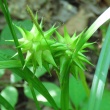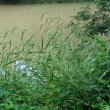Difference between revisions of "Grasses"
Jump to navigation
Jump to search
Jenny Hill (talk | contribs) m |
Jenny Hill (talk | contribs) m |
||
| (One intermediate revision by the same user not shown) | |||
| Line 1: | Line 1: | ||
[[No- | [[No-mow]] | ||
{{:Graminoids:List}} | {{:Graminoids: List}} | ||
{{:Turf | {{:Turf}} | ||
Latest revision as of 14:27, 1 October 2018
No-mow For turf grasses used to control erosive flow in swales, see Turf
Many of the images on this page have some from contributors at iNaturalist.
Search their database for beautiful images; always check the individual CC copyright terms.
| Scientific Name | Common Name | Native | Soil Moisture 1=Dry 2=Med 3=Wet |
Partial shade tolerance | Drought Tolerance 1=Low 2=Med 3=High |
Salt Tolerance 1=Low 2=Med 3=High |
Pollution tolerance | Compaction tolerance | STEP star! | Illustration |
|---|---|---|---|---|---|---|---|---|---|---|
| Andropogon gerardii | Big Bluestem | Y | 2 | 3 | 2 | Y | ☆ | 
| ||
| Bromus latiglumis | Broad-glumed Brome | Y | 2-3 | Y | 2 | 2 | 
| |||
| Calamagrostis acutiflora 'Karl Foerster' | Karl Foerster Feather Reed Grass | 1-2 | 2 | 2 | Y | Y | 
| |||
| Calamagrostis canadensis | Canada Blue-joint | Y | 2-3 | 1-2 | 2 | 
| ||||
| Carex atherodes | Awned Sedge | Y | 3 | 2 | 2 | 
| ||||
| Carex bebbii | Bebb’s Sedge | Y | 2-3 | 1-2 | 2 | Y | 
| |||
| Carex brevior | Brevior Sedge | Y | 1-2 | 2-3 | 2 | Y | 
| |||
| Carex crinita | Fringed Sedge | Y | 2-3 | Y | 1 | 1 | 
| |||
| Carex grayii | Asa Gray Sedge | Y | 2-3 | Y | 1 | 2 | 
| |||
| Carex hystericina | Porcupine Sedge | Y | 3 | 1 | 2 | 
| ||||
| Carex intumescens | Bladder Sedge | Y | 3 | Y | 1 | 1 | 
| |||
| Carex lacustris | Lake-bank Sedge | Y | 2-3 | Y | 1 | 2 | 
| |||
| Carex lupulina | Hop Sedge | Y | 2 | Y | 1 | 1 | 
| |||
| Carex pensylvanica | Pennsylvania Sedge | Y | 1 | Y | 2-3 | 2 | 
| |||
| Carex stipata | Stalk-grain Sedge | Y | 2-3 | 1 | 2 | Y | 
| |||
| Carex vulpinoidea | Fox Sedge | Y | 2-3 | 1-2 | 2 | Y | Y | 
| ||
| Chasmanthium latifolium | Upland Sea Oats | 2 | Y | 2 | 3 | 
| ||||
| Danthonia spicata | Poverty Oatgrass | Y | 1-2 | 2-3 | 3 | Y | 
| |||
| Deschampsia cespitosa | Tufted Hairgrass | Y | 1 | Y | 2 | 2-3 | 
| |||
| Elymus canadensis | Canada Wild-rye | Y | 1-2 | 2-3 | 3 | Y | 
| |||
| Elymus riparius | River Wild-rye | Y | 2 | Y | 2 | 2 | Y | 
| ||
| Elymus virginicus var. virginicus | Virginia Wild-rye | Y | 2-3 | Y | 2 | 2 | Y | 
| ||
| Festuca spp. (see: other information) | Fescue species. | Y | 1-2 | Y | 3 | 2-3 | Y | Y | 
| |
| Helictotrichon sempervirens | Blue Oat Grass | 1-2 | 2 | 2 | 
| |||||
| Juncus effusus ssp. solutus | Lamp Rush | Y | 2-3 | 1 | 3 | Y | Y | ☆ | 
| |
| Juncus tenuis | Path Rush | Y | 2 | Y | 2 | 3 | Y | 
| ||
| Muhlenbergia mexicana var. mexicana | Mexican Muhly | Y | 2 | Y | 2 | 2 | 
| |||
| Panicum virgatum | Shenandoah Switchgrass | Y | 1-3 | Y | 3 | 3 | Y | Y | ☆ | 
|
| Pennisetum alopecuroides 'hameln' | Fountain Grass | 1-2 | 3 | 3 | ☆ | 
| ||||
| Schizachyrium scoparium (Andropogon scoparius) | Little Bluestem | Y | 1 | 3 | 2-3 | Y | Y | ☆ | 
| |
| Schoenoplectus tabernaemontani (Scirpus validus) | Soft-stem Bulrush | Y | 3 | 1 | 2-3 | Y | 
| |||
| Scirpus atrovirens | Dark-green Bulrush | Y | 3 | 1 | 2 | Y | 
| |||
| Scirpus cyperinus | Cottongrass Bulrush | Y | 3 | 2 | 2 | 
| ||||
| Sorghastrum nutans | Yellow Indian-grass | Y | 1-2 | Y | 3 | 2-3 | Y | 
| ||
| Sparganium eurycarpum | Large Bur-reed | Y | 3 | Y | 1 | 2 | 
| |||
| Spartina pectinata | Prairie Cordgrass | Y | 2-3 | Y | 2 | 2 | Y | 
| ||
| Sporobolus neglectus | Small Dropseed | Y | 1-2 | 3 | 3 | Y | Please submit a photo | |||
| Typha latifolia | Broad-leaf Cattail | Y | 3 | 1 | 2-3 | Y | 
|
Links[edit]
Resilient turf grasses are particularly useful in the design of vegetated filter strips, dry ponds and enhanced grass swales. The Ministry of Transportation have standardized a number of grass mixes[1]. The 'Salt Tolerant Mix' is of particular value for low impact development applications alongside asphalt roadways and paved walkways.
| Common name | Scientific name | Proportion |
|---|---|---|
| Tall Fescue | Festuca arundinacea | 25 % |
| Fults Alkali Grass | Puccinellia distans | 20 % |
| Creeping Red Fescue | Festuca rubra | 25 % |
| Perennial ryegrass | Lolium perrenne | 20 % |
| Hard Fescue | Festuca trachyphylla | 10 % |
- ↑ Ontario Provincial Standard Specification. (2014). Construction Specification and for Seed and Cover OPSS.PROV 804. Retrieved from http://www.raqsb.mto.gov.on.ca/techpubs/ops.nsf/0/3a785d2f480f9349852580820062910a/$FILE/OPSS.PROV 804 Nov2014.pdf